An in-depth report on the state of the industry amid shifting consumer trends, coupled with a look at promising possibilities that could spell a win-win for consumers and wineries
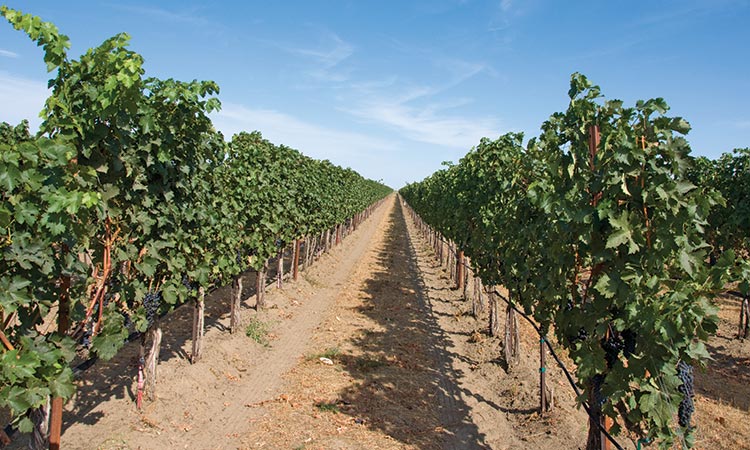
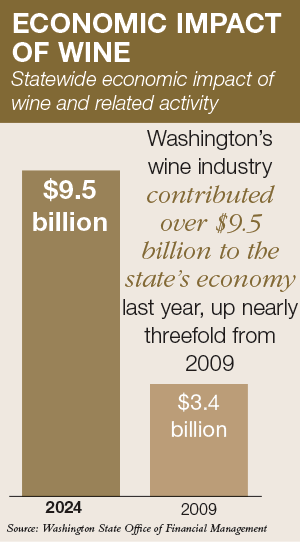 WASHINGTON STATE is the second largest wine producer in the United States, with an output of more than 17 million cases annually. The wine industry contributed over $9.5 billion to the state’s economy last year, up nearly threefold from $3.4 billion when Washington Tasting Room Magazine began publishing in 2009.
WASHINGTON STATE is the second largest wine producer in the United States, with an output of more than 17 million cases annually. The wine industry contributed over $9.5 billion to the state’s economy last year, up nearly threefold from $3.4 billion when Washington Tasting Room Magazine began publishing in 2009.
Even with the recent slowdown of wine sales worldwide, Washington’s wine industry continues to find growth areas. One key sector of growth relevant to all wineries is Direct-To-Consumer, a category that encompasses all retail sales made through tasting rooms and wine clubs, thus avoiding wholesale distributors and allowing earnings to flow directly to the wineries instead. This strategy has been, and will continue to be, a win-win for both consumers and wine producers in the near and distant future.
Increase in Wineries
Statewide, the total number of wineries has jumped to 1,069, adding nearly 200 new ones to the roster over the past decade. The majority are small businesses, a notable statistic when you take into consideration that 90 percent, around 960 wineries, produce under 5,000 cases per year. All however are mindful about quality, from wineries with modest staffing to those with scaled-up operations.
With a show of spunk, newer wineries opened in Washington even during the pandemic years, albeit at a slower pace; in pre-pandemic 2019 the total figure sat at 1,000 wineries.
A constant attraction for consumers is the fact that wines from Washington have a high quality-to-price ratio. This is largely due to relatively low land prices, enabling the state’s roughly 400 grape growers to produce quality grapes at a lower price point than their main competitors from California and Oregon.
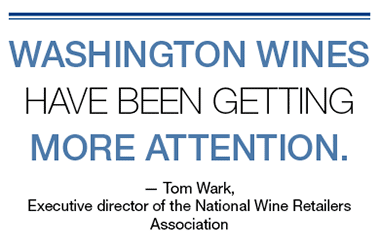 The state’s wine industry faces the opportunity to meet the shifts in trends by tapping into tourism and consumers via wine clubs, and through creating tasting room environments and experiences—including, but not limited to, unique foods, live music, overnight stays, and event planning that draws in newcomers and club members alike.
The state’s wine industry faces the opportunity to meet the shifts in trends by tapping into tourism and consumers via wine clubs, and through creating tasting room environments and experiences—including, but not limited to, unique foods, live music, overnight stays, and event planning that draws in newcomers and club members alike.
High Quality Harvest
The total 2023 harvest produced 159,000 tons of wine grapes, a drop of one-third from the prior year’s crop. The state’s largest winery, Ste. Michelle Wine Estates, had announced to its contracted Washington wine grape growers in 2023 that it would be taking in 40 percent less grapes.
“Our winegrowers were thrilled about the quality of the 2023 fruit,” says Kristina Kelley, executive director of the Washington State Wine Commission. “Despite the small crop, there will be plenty of world-class Washington wine coming out of this vintage. The small harvest is due to a number of factors, but mostly forces in the local and national wine market.”
Cabernet Sauvignon is far and away the top grape varietal in the state, according to the latest statistics, representing a mighty 30.5 percent of the state’s entire grape harvest, taking in 48,369 tons. Riesling and Chardonnay fill in the next two top spots, respectively, accounting for 15 percent and 14 percent of the total harvest.
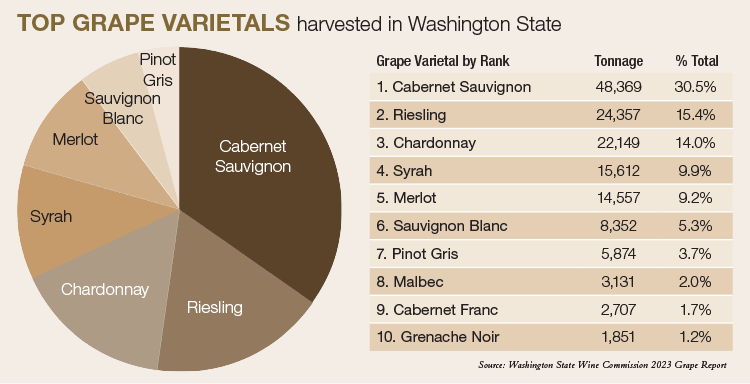
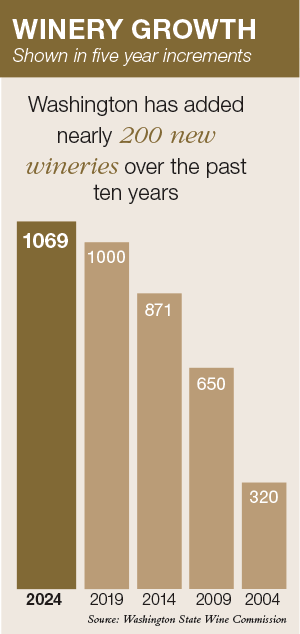 Washington Bucks National Trends
Washington Bucks National Trends
Globally the wine industry has experienced a downturn in sales in recent years as a younger generation of consumers are faced with a bevy of alternative beverage choices. Other factors play a role, such as inflation and a widening age gap among wine drinkers. But how are Washington State wineries faring?
Washington wineries have certainly felt the economic pivot of the last couple years. Still, there are positive signs.
“While the current wine landscape continues to be challenging, there are several notable opportunities for Washington,” says Kristina Kelley. “We continue to see growth in volume share in the $15 to $25 price range, direct-to consumer and export sales. Washington has a significant opportunity to increase volume in the higher price ranges, where we are seeing growth already.”
She is also optimistic about capturing more growth in wine tourism, pointing out that “new consumers are seeking out experiences and discovery.”
Direct-to-consumer retail sales surprised wine analysts by going up five percent in Washington between 2022-2023, according to data from ShipCompliant. Some wineries even reported an increase in sales that went beyond that in the period between 2023-2024. Industry analysts point to reasons why Washington wines are gaining more fans at a time when the industry is struggling nationally.
“My impression is that Washington wines have been getting more attention,” says Tom Wark, executive director of the National Wine Retailers Association and owner of Wark Communications in Oregon, who helped author the ShipCompliant data.
Wark speculates that even as the negative trend included Ste. Michelle Wine Estate’s drawing down of vineyards across the state, other smaller wineries have been able to pivot, creating new opportunities and attracting new customers.
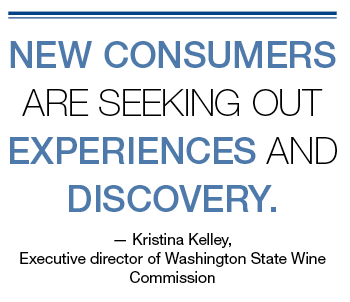 “With Ste. Michelle giving up 40 percent of their vineyards, there are a lot of interesting vineyards and grapes that other wineries can now have access to, and it’s possible that the price of grapes will come down in Washington because those growers will need to find a place to sell their grapes,” says Wark.
“With Ste. Michelle giving up 40 percent of their vineyards, there are a lot of interesting vineyards and grapes that other wineries can now have access to, and it’s possible that the price of grapes will come down in Washington because those growers will need to find a place to sell their grapes,” says Wark.
Sticky Factor
A number of wineries offer wine tourism guest experiences that create a sticky factor that resonate with consumers. Scott and Denise Whitman, who own Whitman Hill Winery & Estate Vineyard located in Zillah, know the value of creating such experiences for their customers. “It’s the biggest goal for us,” says Scott. “The experience is what ties you to a wine and to that winery, and it builds repeat business.”
Creating a sense of place, giving customers a reason to come back and helping them feel a sense of personal investment in the story of their wines is how the Whitmans have built their winery since they opened their estate vineyard in 2020.
One of the ways they’ve done that is by taking guests on guided-tour rides through the vineyard on a five-passenger UTV (utility task vehicle).
“On the tours, we talk with visitors about each block and how the vineyard is laid out, the differences in the vine,” explains Scott Whitman. “We’ll stop and get out, talk about the vines and pick some fruit and taste varietals.” Each tour features a driver whose knowledge provides an overview of everything the Whitmans do from vineyard to bottle, even the history of the grapes.
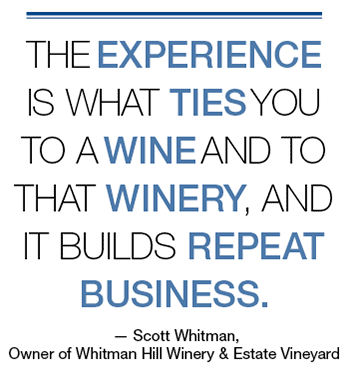 “What better way to learn about the wine you’re sipping than to go up and see where it started,” agrees Denise Whitman. “Our customers can taste grapes from the vines, and then go back to the tasting room to see what those grapes will become.”
“What better way to learn about the wine you’re sipping than to go up and see where it started,” agrees Denise Whitman. “Our customers can taste grapes from the vines, and then go back to the tasting room to see what those grapes will become.”
Surge of Satellite Tasting Rooms
Andrew Browne, CEO and founder of Browne Family Vineyards and Precept Wine & Spirits, says he’s seen more customer traffic in the tasting rooms. “You always get concerned when the economy is questionable,” Browne says, “but we’re definitely keeping our communities and our villages enticed and excited about enjoying our products.”
The Browne Family Vineyards and Precept wine brands’ tasting rooms all focus on the customer experience. “Ever since Covid, people want experiences. Their expectation level is at an all-time high, so the place they walk into, what it looks like, the sounds, the service, the smile, to the products being offered, you have to tick off all those boxes.”
Part of creating that success is Washington state law HB 1038, which went into effect in July of 2017. The law allows a winery to operate as many as five tasting rooms (including their production facility). “Having five licenses is really smart of the state,” Browne comments. “I’d actually like to see that number higher, or even unlimited, but it’s a good start.”

Browne believes the combination of tourist traffic, plus a good sense of local foot traffic is key to growing direct-to-consumer sales. “When you look at the tourism side and the bigger markets, and where we’re seeing new tasting rooms, you can start in Vancouver, WA on the waterfront, and then see both Seattle and Tacoma, and places like Olympia, Gig Harbor and places like Bainbridge island who all see a lot of tourists,” he says.
Josh McDonald is executive director of the Washington Wine Institute, a lobbying group that focuses on the wine industry’s legislative needs, such as successfully passing HB 1038. He says creating these additional satellite tasting room experiences have become a central focus for a lot of wineries, both small and large.
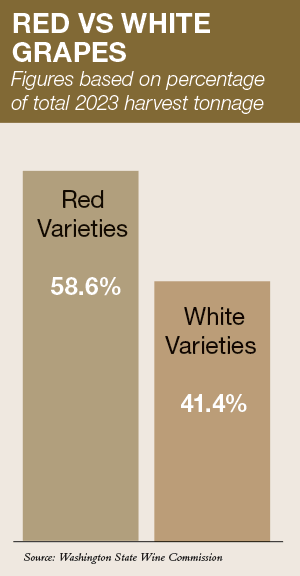 “We’ve seen this growth that sort of gets away from mainly asking people to come to the winery production facilities, and moving ourselves into more urban centers where the population bases are,” McDonald points out. “Originally, a winery could have retail on its production site plus two more locations. So, this was almost a doubling of the amount allowing two more retail spaces.”
“We’ve seen this growth that sort of gets away from mainly asking people to come to the winery production facilities, and moving ourselves into more urban centers where the population bases are,” McDonald points out. “Originally, a winery could have retail on its production site plus two more locations. So, this was almost a doubling of the amount allowing two more retail spaces.”
Satellite tasting rooms offer exposure for consumers to taste Washington wines grown elsewhere in the state. “If a winery has more than one tasting room, it’s an opportunity to showcase its wines to new consumers in that area,” adds Kristina Kelley. “If a satellite tasting room is in a highly-populated area like Woodinville or Vancouver, WA their customers might be more likely to plan a trip to the vineyards in Yakima Valley or Walla Walla.”
Wine Clubs Dominate
Woodinville, which features wines from 19 of the 20 Washington AVAs (American Viticultural Areas), has five different tasting room districts in the city, all of which have wine tasting rooms in a variety of settings.
“A majority of what the Woodinville wineries are servicing are their wine clubs,” says Adam Acampora, executive director of Woodinville Wine Country association.
“About 68 percent of our tasting room sales are going to a club member. I’ve talked to some wineries here who say that number is up to 80 percent.”
Wineries in Woodinville offer wide-ranging customer experiences, from trivia games, live music entertainment, painting parties and other events, to ice cream and wine flights. Acampora admits several of the wineries find themselves in a philosophical struggle of what their business model should be: are they a winery, a restaurant, or an event center? He believes a lot of winemakers get into the business for love of the craft and want the business to be solely about the wine—not food pairings, or live music, or other engagements, which he says might put those wineries in an awkward position with customers who may be seeking additional experiences.
Experiencing La Dolce Vita
For many Washington winemakers, while they certainly pay attention to the economy, they are seeing more growth. “I hate to be such a carrier of good news in times of difficulty in the industry, but we had 20 percent growth last year,” says Bob Jankelson, owner of Tsillan Cellars in Lake Chelan and Woodinville. “We’ve grown 13 percent this year. I have no visions of getting bigger, we’re just below 10,000 cases annually and we’re comfortable there.”
According to Jankelson, Ste. Michelle Wine Estates was the reason that Washington has enjoyed success unique to the wine industry for many years. “They’re what I call a benevolent gorilla. They took care of us little guys, and they promoted Washington wine and they also funded research and shared that, which allowed the little guys to flourish.”
But Jankelson says those golden days of Ste. Michelle are gone now. He is referring, of course, to the sale of Ste. Michelle Wine Estates in 2021 to a private New York-based equity firm, whose new owners have slashed vineyard production statewide, and this past summer sold off its stake in Col Solare on Red Mountain, as well as Stag’s Leap in Napa, with plans to construct housing and commercial real estate on the Chateau Ste. Michelle property in Woodinville.
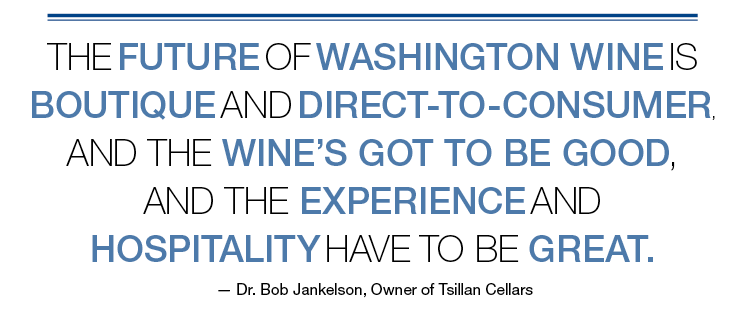
“The future of Washington wine is going to be boutique and direct-to-consumer, and the wine’s got to be good, and the experience and hospitality have to be great,” advises Jankelson.
Tsillan Cellars runs a restaurant at the Lake Chelan winery called Sorrento’s Ristorante, and both the Woodinville tasting room and the Chelan winemaking facility hold events, pairings and other experiences for customers. “I want customers to experience la dolce vita,” says Jankelson. “I want them to put their cares aside, and see the lake, the mountains and the vineyards, enjoy some wine and forget about all those cares, and indulge in that moment—that’s what I want to give them.”
Stronger AVA Awareness
Bob Jankelson believes that Washington’s continued exploration and opening of American Viticultural Areas (AVAs) is another driver in the Washington wine market. With 20 AVAs and more on the way, Washington’s diverse geography allows it to grow unique varietals that other states, even California, aren’t making in abundance. Such as Albarino, Primitivo, Dolcetto, Pinot Gris and others.
“There’s no question that we know our craft better now,” says Jankelson. “We have technologies at our fingertips we didn’t dream about 20 years ago, so we are opening up new vineyards. Every AVA is different, and the challenge is to nurse the very best quality and consistency from what the soil, geography and sunshine give you.”
Kristina Kelley agrees with Jankelson that each AVA is unique. “As Washington gains additional official AVAs, it’s a sign that our industry is continuing to grow,” she says, adding, “It’s important to some winegrowers to be able to legally distinguish a region from others. Wineries can choose to label their wine with a sub-AVA as a way to communicate to consumers where the wine is grown in a rather precise manner.”
The 21st and newest AVA being considered is the Mount St. Helen’s winegrowing region in southwest Washington, which encompasses the city of Vancouver and portions of Clark, Cowlitz and Lewis counties.
Many Varieties Done Well
One of the Washington wine industry’s hallmarks is that it doesn’t hang its fame on a single grape varietal. From Riesling, among the earliest and popular grapes produced here in large volume, to Cabernet to Syrah, and even lesser-known wines like Dolcetto and Nebbiolo, they can all be grown to exceptional standards in this region.
“I think if you ask anyone in the wine industry anywhere where you can get the best Syrah in America, they’ll say Washington,” wine analyst Tom Wark admits. “But the state does a lot of wines well—there isn’t just one that’s associated with it, like Napa Cabernet Sauvignon or Oregon Pinot Noir.”
“White wines are performing a bit stronger than red nationally, especially with the Gen Z demographic,” says Kristina Kelley. “We see an opportunity here, especially for Sauvignon Blanc and Pinot Gris, which continue to rise in the percentage of our annual production.”
The state’s wineries and grapegrowers show little complacency, and have been successful working together through past changes and emerging ever stronger as a result. As the famous Dr. Walter Clore, hailed “The Father of Washington Wine,” noted many years ago: “Washington retains vast potential capacity to expand the production of premium wine grapes and thus for continued successful growth of its wine industry and the many related benefits the industry brings to the state and communities of Washington.”
Written by editor John Vitale and writer Mark Storer
